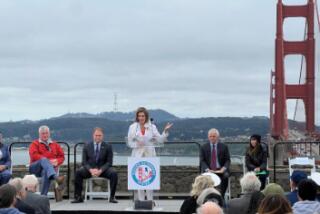The Gate: THE TRUE STORY OF THE DESIGN AND CONSTRUCTION OF THE GOLDEN GATE by John van der Zee (Simon & Schuster: $19.95; 355 pp.)
- Share via
Great works in California often have been attributed to great men--visionaries and pioneers who dreamed of doing the impossible. They braved the elements and the odds to carry their dreams into reality for the benefit of mankind. The Big Four built the western segment of the transcontinental railroad. William Mulholland brought water from the Owens Valley to Los Angeles. San Francisco had Michael O’Shaughnessy, the city engineer who went 245 miles into the Sierra Nevada for water, damming the Tuolumne River in the Hetch Hetchy Valley of Yosemite National Park. Naturalist John Muir considered the construction of O’Shaughnessy Dam an infamy, but O’Shaughnessy prevailed, with the assistance of President Theodore Roosevelt.
And to San Francisco came Joseph Bauermann Strauss, who is credited to this day with being the man who designed and built the Golden Gate Bridge.
But the great men who built the great projects often were quite mortal after all, sometimes copping their visionary ideas from other people. The Big Four defrauded the government in building their railroad after stealing the concept from Theodore Judah. Mulholland suffered the ignominy of a dam collapse that killed 450 people. When O’Shaughnessy was excluded from the actual design and construction of the Golden Gate Bridge, which he considered his idea in the first place, he turned against the project altogether.
As for Strauss, we learn in “The Gate” that while he was chief engineer of the Golden Gate Bridge project, he was not really an engineer. And while he is universally credited with the design of the bridge, that achievement was the work of another man, Charles Ellis, a University of Illinois professor of structural engineering, who was fired by Strauss when Ellis’ own personal fame became a threat to Strauss’ considerable ego.
The restoration of Ellis’ role in the bridge design is John van der Zee’s major disclosure, thus justifying the enticing promise of the subtitle to tell the “true story.” This is not exactly the revelation of a major scandal, but it does help put history aright and provide another reason for another book on the Golden Gate Bridge.
Perhaps the fact that the bridge is 50 years old in 1987 is reason enough. Van der Zee elevates the story from engineering-journal level by writing at length about the people involved in building the 1.2-mile span linking San Francisco with the Marin headlands across the entrance to San Francisco Bay. At the outset, we discover that Strauss is best known for inventing something called the trunnion bascule bridge and that he is a man with a sort of P. T. Barnum character, a mix of “promoter, mystic, tinkerer, dreamer, tenacious hustler, publicity seeker, recluse.”
By the end, Strauss has not risen much above that level. His real achievement over his two decades of association with the project was not the bridge itself, but the organization of the Golden Gate Bridge District, a political entity, Van der Zee says.
This is not exactly high drama, but for readers who are attracted to such things, the bridge itself is fascination enough to hold the story together. And the fact of its design is crucial to its acceptance as an American symbol rivaling that of the Statue of Liberty. Strauss’ lack of vision, in an engineering sense, is evident in his own proposed design. It would have resembled, Van der Zee writes, the ugly railroad bridges of the day, “dark and ponderous . . . something out of the early industrial era of soot and smoke.” Strauss had the good sense to abandon his design after Ellis produced a plan of airy grace, “a link to the natural world of air and water and light.”
Van der Zee also raises, fleetingly, the intriguing question of whether the Golden Gate would have better been left unbridged. He quickly concludes that while the open Gate was one of the most beautiful natural vistas of the world, “the feeling we are left with, upon seeing (in photos) the unbridged Golden Gate, is not regret, but incompleteness, as if all this, beautiful as it was, was prelude, waiting for the bridge itself to satisfy our hunger for fulfillment.”
Van der Zee’s effusive sense of destiny in favor of the bridge, claiming that it enhances the natural setting, might draw some credible arguments. However, since most people have never seen the Gate without its bridge, it is impossible for them to visualize the open Gate from a standpoint of whether to build or not build. If a bridge had to be built, however, it is fortunate that it was Ellis’ design and not Strauss’ clunky trunnions. Good fortune and good sense prevailed as well, Van der Zee informs us, in choosing the color of paint for the bridge. Irving Morrow, a consulting architect, succeeded in holding out for the red-orange color--originally applied as a temporary undercoating--that he thought best related the bridge to the landscape.
The engineers wanted an aluminum color. And the Navy sought to have the bridge painted in yellow and black stripes for better visibility to shipping. Somehow, a yellow-and-black-striped span would not seem to fit Van der Zee’s description of the Golden Gate and its bridge as “perhaps the most successful combination of site and structure since the Parthenon.”
More to Read
The biggest entertainment stories
Get our big stories about Hollywood, film, television, music, arts, culture and more right in your inbox as soon as they publish.
You may occasionally receive promotional content from the Los Angeles Times.










